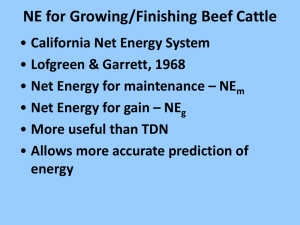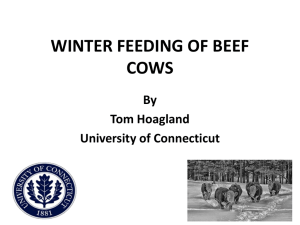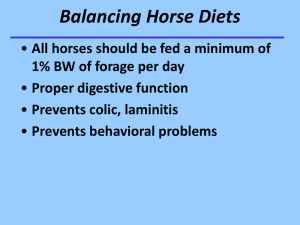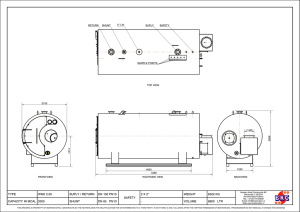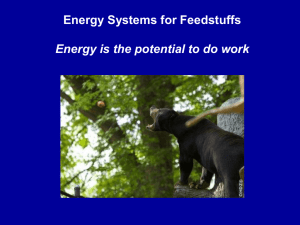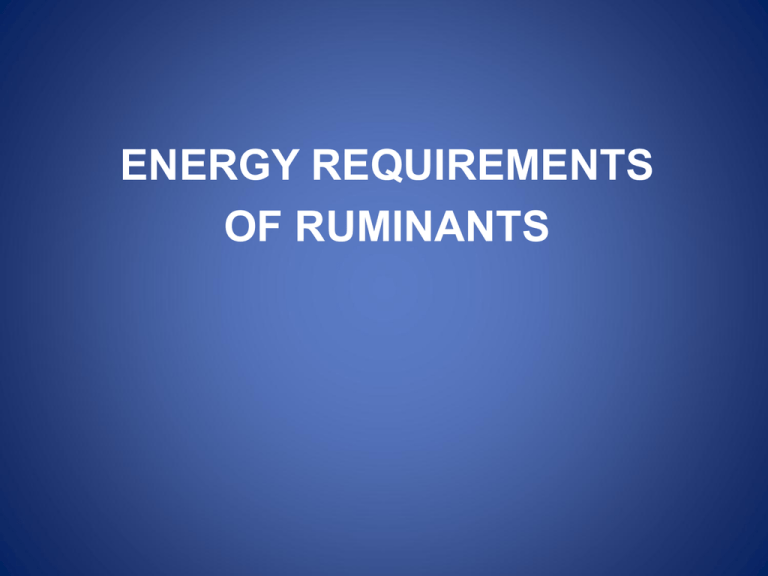
ENERGY REQUIREMENTS
OF RUMINANTS
FEED ENERGY SYSTEMS
• Total digestible nutrients (TDN)
– Traditional system to express digestible energy
concentration of feedstuffs
– Basis of TDN are physiological fuel values
Nutrient
Heat of
combustion,
kcal/gm
Heat of
combustion
of metabolic
products,
kcal/gm
Nutrient
absorption, %
Physiological
fuel value,
kcal/gm
Carbohydrates
4.1
-
98
4.0
Fats
9.45
-
95
9.0
Protein
5.65
1.30
92
4.0
– TDN, %DM = %DP + %DCF + %DNFE + (2.25 x
%DEE)
• Equivalence in energy units
– 1 lb TDN = 2000 kcal Digestible Energy
– 1 kg TDN = 4400 kcal Digestible Energy
• Limitations of TDN
– Limitations with digestion trials
• Errors in chemical analyses
• Errors in digestibility trials
– Low feed intake increases digestibility
– DMI at 3x maintenance reduces TDN by 8%
– Underestimates or does not include all energy losses in
metabolism
• Underestimates energy loss in urine (5%)
• Does not include methane gas
– End product of rumen fermentation
– 3 – 10% of feed energy
• Does not include:
– Work of digestion
– Heat of fermentation
– Heat of nutrient metabolism
– Overestimates the usable energy value of feeds
• Particularly of forages
CALORIC SYSTEM
• Energy units
– Calorie (cal)
• Amount of heat required to increase the temperature of 1
gm of water from 14.5 to 15.5oC
– Kilocalorie (kcal) = 1000 cal
– Megacalorie (Mcal) = 1000 kcal = 1,000,000 cal
• Caloric system subtracts digestion and
metabolic losses from the total energy of a
feedstuff
CALORIC SYSTEM
Gross Energy
Fecal Losses
Digestible Energy
Urine Losses
Gaseous Losses
Heat Increment Losses
Work of
Digestion
Heat of
Fermentation
Heat of
Nutrient
Metabolism
Metabolizable Energy
Net Energy
Maintenance
Retained Energy
Lactation
Stored Energy
Growth
COMPARISON OF ENERGY FRACTIONS
IN DIFFERENT FEEDSTUFFS
Corn
grain
kcal/g
Alfalfa Hay
(midbloom)
kcal/g
Oat Straw
kcal/g
Gross Energy
4.5
4.6
4.7
Digest. Energy
3.92
2.56
2.21
Metab. Energy
3.25
2.10
1.81
NEm
2.24
1.28
0.97
NEg
1.55
0.68
0.42
CALCULATION OF ENERGY VALUES IN BEEF
NRC REQUIREMENT PUBLICATION
• DE = .04409 x TDN (%)
• ME = DE x 0.82
• NEm = 1.37ME-0.138ME2+0.0105ME3-1.12
• NEg = 1.42ME-0.174ME2+0.0122ME3-1.65
where units for DE, ME, and NE are Mcal/kg
CALCULATION OF TDN CONCENTRATIONS IN
DAIRY NRC REQUIREMENT PUBLICATION
• Inputs
• tdNFC = .98(100-[(NDF-NDICP)+CP+EE+ash])xPAF
where PAF = .95 for cracked corn
1.00 for ground corn
1.04 for HM corn
.94 for normal corn silage
.87 for mature corn silage
•
•
•
•
tdCPf = CP x e(-1.2xADICP/CP)
tdCPc = [1 – (0.4 x (ADICP/CP))] x CP
tdFA = FA
tdNDF = 0.75 x [(NDF-NDICP)-L) x [1 – (L/(NDF-NDICP)).667]
• TDN
• TDN1x= tdNFC + tdCP + (2.25 x tdFA) + tdNDF – 7
• Other specific equations for animal protein supplements and fat
supplements
CALCULATION OF ENERGY CONCENTRATIONS
IN DAIRY NRC REQUIREMENT PUBLICATION
• DE1x (Mcal/kg) = (tdNFC/100) x 4.2 + (tdNDF/100) x
4.2 + (tdCP/100) x 5.6 + (FA/100) x 9.4 – 0.3
• Intake discount = [(TDN1x – [(0.18 x TDN1x) – 10.3] x
Intake)] / TDN1x
where intake is a multiple of maintenance
• MEp (Mcal/kg) = [1.01 x DEp – 0.45] + 0.0046 x (EE – 3)
• NElp
– For feeds with < 3% EE
NElp (Mcal/kg) = [0.703 x MEp] – 0.19
– For feeds with > 3% EE
NElp (Mcal/kg) = [0.703 x MEp] – 0.19 + ([(0.097x MEp + 0.19)/97]
x [EE – 3])
DISCOUNT FACTORS FOR TDN FOR RATIONS
WITH DIFFERENT TDN1X AT INCREASING
LEVELS OF DM INTAKE
Energy balance
Efficiency of NE
+
Lactation (64%)
Growth (25 – 45%)
0
-
Maintenance (60 – 70%)
73.5 kcal NE/kg.75
Energy intake
Implications of differences in efficiency
of energy use for different functions
• When calculating energy needs
– Mature dairy cattle can use one value to express the needs
for maintenance and lactation (NEl)
– Growing cattle must use separate values to express the
needs for maintenance (NEm) and gain (NEg)
Energy requirements
• Maintenance
– % of total energy requirement
• 25 – 70% in dairy cattle
• 70% in beef cattle
– Components
• Basal metabolic rate
• Activity
• Body temperature regulation
• Pregnancy
• Growth
• Lactation
CALCULATION OF THE MAINTENANCE
REQUIREMENTS FOR NET ENERGY
FOR BEEF AND DAIRY CATTLE
• Beef cattle
– NEm = 0.077EBW.75
• Dairy cattle
– NEl for maintenance = 0.080BW.75
MAINTENANCE MODIFIERS
(All except lactation apply across sexes)
• Breed
Maintenance
Breed
Kcal ME/BW.75
Mcal/d
% of total
annual ME
Angus x
Hereford
130
14
73
Charolais x
129
15
73
Jersey x
145
14.2
71
Simmental x
160
17.9
75
– Implications
• Maintenance requirements of breeds with high milk potential
are 20% higher than those with low milk potential
– Maintenance requirements of Bos indicus breeds are 10% lower than
Bos taurus
• Maintenance represents 70% of total annual ME requirement
of beef cows
– Match cow breeds to feed resources
RELATIONSHIP OF BIOLOGICAL
EFFICIENCY AND FEED AVAILABILITY
___Breed__
Red Poll
Angus
Hereford
Pinzgauer
Gelvieh
Braunvieh
Limousin
Simmental
Maximum
efficiency
DMI at Max
efficiency
gm calf
weaned/kg DMI/
cow exposed
47.1
41.3
35.1
46.9
44.5
39.4
39.4
41.5
kg/yr
3790
4111
4281
5473
5475
7031
7498
8609
DMI, kg/yr
3500
7500
gm calf
weaned/kg DMI/
cow exposed
47
24
39
17
30
13
38
44
29
36
33
42
33
42
26
42
• Effects of feed availability on biological efficiency
– Rebreeding rates
– Weaning weights
• Reasons for difference in energy requirements
between breeds
– Difference in energy expenditure of visceral organs
Organ
Linear contrast (High milk
prod vs low milk prod),
g/kg.75
Heart
1.92
Lung
5.52
Kidney
1.86
Liver
5.83
Blood flow = 25% of cardiac
output
O2 consumption = 15% of total
GI tract
-
Blood flow = 20% of cardiac
output
O2 consumption = 11% of total
– Difference in protein and fat turnover
• Efficiency of protein accretion = 40%
• Efficiency of fat accretion = 60 to 80%
• Sex
– Increase NEm requirement by 15% for bulls
• Lactation
– Maintenance requirement of lactating cows is 20%
higher than dry cows
– Implications
• Early weaning of beef cows reduces maintenance energy
requirement
– Reduces feed use
– Stimulates reproduction
Postpartum
energy fed
Weaning
systems
Low (70%
NRC)
Early (38 days) 62.5
Medium
% cows
cycling 60 d
post-partum
Normal (7 mo)
26.7
Early
88.9
Normal
13.3
• Body condition effects
– Reflects previous nutrition
– NEm = 0.077BW.75 x (.8 + ((CS-1) x .05)
– Implications
• Can have compensatory gain in growing cattle or reduce
feed requirements of beef cows by restricting nutrition
• Activity allowance (Beef)
– Variation
• 10-20% increase in NEm reqt. for good pasture
• 50% increase in NEm reqt on poor hilly pasture.
– Nemact = [(.006 x DMI x (.9 – TDN)) + (.05T/(GF + 3))]
x w/4.184
Where DMI is in kg/d
TDN is a decimal
T is terrain (1=flat, 1.5=undulating, 2=hilly)
GF is green forage available in metric ton/ha
• Activity allowance (Dairy)
– Walking
• Adjustment = .00045 Mcal Nei/kg BW/horizontal km
– Eating
• Adjustment = .0012 Mcal Nei/kg BW
• Assumes 60% of diet is pasture
– Walking
• Adjustment = .006 Mcal Nei/kg BW
• Assumes a hilly pasture is one in which cattle move 200
m of vertical distance/day
– Example
% increase in maintenance
Flat, close to parlor,
good pasture
Hilly, far from parlor,
good pasture
Horizontal movement
2.8
11.4
Eating
7.6
7.6
Terrain
-
37.9
Total
10.4
56.9
TEMPERATURE EFFECTS
• Previous temperature
– Adjustment
• NEm = (.0007 x (20-Tempprevious) + 0.077) Mcal/BW.75
Body temperature regulation
High
Heat
Production
LCT
Normal LCT (Cattle)
Fasted 18-20C
Fed
7C
UCT
HI
LCT
Low
UCT
Activity
LCT
UCT
Basal Metabolic Rate
39 C
Low
Temperature
High
Effects in applied nutrition
• Mature dairy cows
– Cold stress
• Not considered by NRC
• Reasons
– High heat production
– Maintained in confinement
– Heat stress
• Increase maintenance NE requirement by 25%
• Beef cattle (and dairy heifers)
– Cold stress may have major effects on
NEm requirement
– Components
• Surface area = SA = .09BW.67
• External insulation = EI = (7.36 – 0.296 Wind +
2.55 Hair) x Hide x Mud
– Determined by:
» Wind
» Coat length
» Hide thickness
» Mud or snow
Some mud
Wet matted
Snow covered
Effects on EI
-20%
-50%
-80%
• Internal insulation = II = 5.25 + (.75 x CS)
– Adult cattle
Total insulation = TI = EI + II
• Diet heat increment = HI = (MEI-NEI)/SA
– Calculations
Lower Critical Temp = LCT = 39 – (TI X HI x 0.85)
NEcold stress = SA (LCT-Current temp)/TI x Diet NEm
Diet ME
Add to NEm requirement for total Nem requirement
Example: 600 kg cow (BCS = 5) with a dry coat
at -5C temp.
Cow BW NEm reqt DM intake BCS
kg
Mcal/day kg
600 9.334782
15
Wind
km/h
5
Coat length Hide thickness Coat cover
cm
Factor
Factor
7.5
2.54 Average (1)
Dry (1)
Surface area = .09 BW.67
EI=
II=5.25+(.75XCS)
Total insulation=
6.540393032
11.617
9
20.617
ME intake = DMI X ME conc
NE intake = DMI X NE conc
Heat increment = (MEI-NEI)/SA
40.2
26.4
2.109964941
Lower critical temp =(39-(TI x HI x .85)
NEcold stress = SA x ((LCT-Current temp)/TI) * Diet NE/Diet ME
2.024024886
1.463330052
Diet ME Diet NE Current temp
Mcal/kg Mcal/kg C
2.68
1.76
-5
Example: 600 kg cow (BCS = 5) with a snowcovered coat at -5C temp.
Cow BW NEm reqt DM intake BCS
kg
Mcal/day kg
600 9.334782
15
Wind
km/h
5
Coat length Hide thickness Coat cover
Diet ME Diet NE Current temp
cm
Factor
Factor
Mcal/kg Mcal/kg C
7.5
2.54 Average (1)
Snow cov (.2)
2.68
1.76
-5
Surface area = .09 BW.67
EI=
II=5.25+(.75XCS)
Total insulation=
6.540393032
2.3234
9
11.3234
ME intake = DMI X ME conc
NE intake = DMI X NE conc
Heat increment = (MEI-NEI)/SA
40.2
26.4
2.109964941
Lower critical temp =(39-(TI x HI x .85)
NEcold stress = SA x ((LCT-Current temp)/TI) * Diet NE/Diet ME
18.69181954
8.986762984
• Heat stress in beef cattle
– Shallow panting = Increases NEm reqt by 7%
– Open mouth panting = Increase NEm reqt by 18%
• Effects of excess protein on NEm requirement
– Needed for synthesis of urea above requirements
– Calculation
• NEm, Mcal/d = [((rumen N balance, gm – recycle N, gm) +
excess N from MP, gm] x .0113) x NEm/MEdiet
– Not included in NRC beef or dairy requirements
•
Included in BRANDS and CNCPS program
Pregnancy
• Very inefficient utilization of energy (14 to 16%)
• Increase energy requirement drastically during last
trimester of gestation
Cattle
Energy reqt in last trimester
% of maintenance
180
• Calculations:
– Beef
• NEm, kcal/d = 0.576 birth wt (0.4504 – 0.000766t)e(.03233.0000275t)t
– Dairy
• NEl, Mcal/d = [(.00318 x t -.0352) x (birth wt/45)]/.218
Bodyweight gain
• Less efficient than maintenance
• Calculations
– NEg intake, Mcal/day *= DMI, kg x NEg conc., Mcal/kg
• *After maintenance requirement is met
– Shrunk BW, kg = SBW = .96 x Full BW
– Standard reference BW = SRW (base = medium-frame
steer)
• 478 kg for small marbling
• 462 kg for slight marbling
• 435 kg for trace marbling
–
–
–
–
Equivalent shrunk BW, kg =SBW x SRW/Final SBW
EBW = .891 x EqSBW
EBWG = .956 x SBWG
Retained energy, Mcal/day = .0635 x EBW.75 x EBWG1.097
• Equals NEg intake if known in predicting gain
– SBWG, kg = 13.91 x RE.9116 x EqSBW-o.6837
• Adjustments for FSBW
• Reduce FSBW by 35 kg if no implant used
• Increase FSBW by 35 kg in Trenbolone acetate is used
with an estrogen implant
• Increase FSBW by 35 kg if extended periods of slow
rates of grain
• Reduce FSBW by 35 kg if fed high energy from weaning
to finish
Example
Predict the rate of gain of a 700 lb (318 kg) Angus steer
(BCS = 5) fed 1.5 kg corn silage, 5 kg corn grain, and 1
kg soybean meal (DM basis) that will finish at 1250 lb
(568 kg) at small marbling with no environmental stress.
• Step 1. Calculate NEm and NEg concentrations
of diet
Feed
DMI, kg
Corn silage
1.5 x
Corn
5x
SBM
1x
7.5
Nem, Mcal/kg = 15.80/7.5 =
Neg, Mcal/kg = 10.77/7.5=
Nem
Mcal/kg Mcal/day
1.69
2.535 x
2.24
11.2 x
2.06
2.06 x
15.795
2.106
– If fed an ionophore, increase NEm conc by 12%
Neg
Mcal/kg Mcal/day
1.08
1.62
1.55
7.75
1.4
1.4
10.77
1.436
• Step 2. Calculate feed required for maintenance
Nem reqt, Mcal/day = .077 BW
BW
BCS
318
.75
x (.8 + ((BCS-1)X.05))
Mcal Nem/day
5 5.798439
Feed for maintenance= Nem reqt/Nem conc
Nem reqt Nem conc Feed for maintenance
5.798439
2.106 2.753295 kg/day
No adjustments for breed or temperature stress needed in this problem
• Step 3. Calculate NEg remaining for gain
Feed for gain = DMI - Feed for maintenance
Total DMI Feedmaint Feedgain
7.5 2.753295 4.746705 kg/day
Neg intake above maintenance =Feedgain X Neg conc
Feedgain Neg conc Neg intake above maintenance
4.746705
1.436 6.816269 Mcal/day
• Step 4. Calculate the Equivalent Shrunk BW
SBW = .96 x Full BW
Full BW
Current
318
Finish
568
SBW
305.28
545.28
EqSBW = CSBW x SRW/FSBW
CSBW
SRW
FSBW
EqSBW
305.28
478
545.28 267.6127
• Step 5. Calculate Shrunk BW gain
SBWG= 13.91 x
.9116
NEgI. x
-.6837
EqSBW
NEgI
EqSBW
6.816269 267.6127
1.75187 kg/day
Lactation
(Dairy)
• Equal efficiency to maintenance
• NEl reqt for lactation, Mcal/day = kg milk/day x
(.0929 x % milk fat) + (.0547 x % milk protein/.93) +
(.0395 x % lactose)
– Simply add to NEl needed for maintenance
• Energy from body tissue loss (5-point BCS scale)
Body condition score
2
2.5
3
3.5
4
Mcal NEl/kg BW loss
3.83
4.29
4.68
5.10
5.57
Example
How much milk with a composition of 3.5% fat, 3.3%
protein, and 5% lactose should a 1450 lb (659 kg)
Holstein cow produce if she is consuming a diet
containing 2 kg alfalfa hay, 5 kg alfalfa haylage, 5 kg
corn silage, 10 kg corn grain, and 2 kg soybean meal
(DM basis)?
• Step 1. Calculate the NEl intake
DMI
kg
Feed
Alfalfa hay
Alfalfa haylage
Corn silage
Corn
SBM
Total
2
5
5
10
2
Nel conc NEI
Mcal/kg Mcal/day
1.38
2.76
1.34
6.7
1.45
7.25
2.01
20.1
2.21
4.42
41.23 Mcal
• Step 2. Calculate the amount of NEl remaining after meeting
the maintenance requirement
.75
Maintenance reqt, Mcal = .08 x BW
BW
Maintenance reqt
659
10.40529 Mcal
Nel remaining for milk production = Total Nel - Nel for maintenance
Total NEL Maint Nel Nel for milk
41.23 10.40529 30.82471 Mcal
• Step 3. Calculate energy concentration in
milk
• Step 4. Calculate milk production
Energy requirment for milk, Mcal/kg = (.0929 x Milk fat) + (.0547 x milk protein/.93) + (.0395 x lactose)
Milk fat Milk proteinLactose Nel reqt.
3.5
3.3
5 0.716747 Mcal/kg milk
Milk production = Nel for milk/(mcal/kg)
Nel for milkMcal/kg milk
30.82471 0.716747 43.00642 kg
Dairy example 2
If previous cow was producing 50 kg/day of milk with
the given composition, how much tissue would she
need to mobilize at a BCS of 3.5?
• Step 1. Calculate total NEl reqt.
Total Nel requirement, Mcal/d = Maintenance + Lactation
Maintenance reqt, Mcal = .08 x BW.75
BW
Maintenance reqt
659
10.40529 Mcal
Lactation reqt, Mcal = kg milk/day x Mcal/kg milk
Kg milk
Mcal/kg milk
50 0.716747 35.83734
Total Nel reqt
46.24263 Mcal
• Step 2. Calculate the energy deficit
• Step 3. Calculate the amount of tissue needed to fill
deficit
Energy Deficient = NE reqd - NE intake
NE reqd NE intake
46.24263
41.23 5.012625 Mcal
Tissue mobilized= NE deficit / NE conc in tissue
NE deficit NE conc, Mcal/kg
5.012625
5.1 0.982868 kg/day
Lactation
(Beef)
• Equations
– k = 1/T
• T = week of peak lactation
– a = 1/(Peakyld x k x exp)
• Peakyld = peak yield, kg/day
– Milk prod, kg/d= Yn = n/(a x expkn)
• n = current week
– E = .092 x MF + .049 x SNF - .0509
• E = Milk energy, Mcal/kg
• MF = Milk fat, %
• SNF = Solids not fat, %
– NEm, Mcal/day = Yn x E
FEEDING TO MAINTAIN REPRODUCTION
• Maintaining reproductive performance requires given
levels of body fat
– No less than 15.8% carcass lipid or 13.5% empty body fat at
parturition
• Can be as low as 12.4% empty body fat at parturition if fed at
130% of NRC energy requirement for 60 days post-partum
– Empty body fat at breeding should be 15% for optimal
pregnancy rates
– Cows should not exceed 20% carcass lipid or 17.8% empty
body fat
• Body weight
– Although NRC publications prior to 1996 used body weight,
most producers don’t weigh cows
– Body weights of pregnant cows can be confounded with
conceptus
USE OF CONDITION SCORING FOR BEEF COWS
• Systems
– 9-point visual system (NRC/Oklahoma)
– 9-point palpation system (Tennessee)
– 5-point visual system (Purdue)
• Limitations
– All systems are subjective
– Different systems make it difficult to standardize relative to
nutrient requirements
• Advantages
– Don’t require weighing of cows
– Less confounded by pregnancy than body weights
– Related to body weight
• Relationship with BW change
– Purdue
– NRC
1 BCS unit change = 68 kg (5-point system)
1 BCS unit change = 50 kg (9-point system)
• Relationship varies with age
– Mature cows 1 BCS unit change = 34 kg (9-point system)
– Primiparous heifers 1 BCS unit change = 68 kg (9 point system)
• Relationship of body condition score to body composition
Component
BCS
Change/BCS (5-point) BCS + BW
Carcass lipid
Carcass protein
Empty body lipid
Empty body protein
Hot carcass weight
Backfat
r
.63
.36
.48
.26
r
.70
.59
.74
.47
.95
.62
5.5-66% units
.2-1% units
.075-.29 cm
• Relationship of BCS from different systems to body lipid
BCS
System
9-pt 5-pt
NRC, 9-pt.
Texas, 9-pt.
Purdue, 5-pt
1
2
3
4
5
6
7
8
9
1
2
3
4
5
3.77
7.54
11.30
Empty body lipid, %
0
4
8
15.07
12
18.89
22.61
26.38
30.15
33.91
16
20
24
28
32
3.1
8.7
14.9
21.5
27.2
• Relationship of body condition score to reproduction
– Body condition score at calving is the primary factor related to
reestablishment of cyclic activity in beef cows
• Cows that calve at BCS > 5 (9-point system) will exhibit estrus
regardless of post-partum nutrition regime
• Feeding extra energy post-partum to cows that calve at BCS < 4 will
increase the percentage of cows exhibiting estrus in a finite
breeding season
Richards (1986)
Days to first estrus
Post-partum
nutrition
<4
High (+.45kg/d) 60
Mod. ( 0 kg/d)
60
Low (-.68 kg/d) 56
L/H (5 kg corn/d 67
14-d before
and through
breeding)
>5
51
46
50
49
Days to conception
Calving BCS
<4
>5
91
84
91
85
88
82
91
87
1st service conception
<4
67
65
54
75
>5
59
67
70
70
BODY CONDITION SCORE EFFECTS ON
ENERGY RESERVES
• Energy in body condition
Body condition score (5-point system)
Mcal/kg BW change
1
2.57
2
3.82
3
5.06
4
6.32
5
7.57
– The reason for this difference is that weight change at
condition score 1 is 17% fat, but is 77% fat at condition score 5
– Implications
• It takes more energy to increase condition score at a higher condition
score than a lower condition score
• Loss of body condition at a high body condition provides more energy
than loss of body condition at a low body condition score
• Calculation of energy from body reserves
– Body composition from BCS
•
•
•
•
•
•
Proportion of empty body fat = AF = .037683CS
Proportion of empty body protein = AP = .200886 - .0066762CS
Proportion of empty body water = AW = .766637 - .034506CS
Proportion of empty body ash = AA = .078982 - .00438CS
Empty body weight, kg = EBW = .851SBW
Total ash, kg = TA = AA x EBW
– Calculation of total fat and protein reserves
•
•
•
•
•
•
•
•
AA1 = .074602
AF1 = .037683
AP1 = .194208
EBW1, kg = TA/ AA1
Total fat, kg = TF = AF x EBW
Total protein, kg = TP = AP x EBW
Total fat1, kg = TF1 = EBW1 x AF1
Total protein1, kg = TP1 = EBW1 x AP1
– Calculation of mobilizable energy
• Mobilizable fat = FM = TF - TF1
• Mobilizable protein = PM = TP – TP1
• Energy reserves, Mcal = ER = 9.4FM + 5.7PM
– During mobilization
• 1 Mcal ER substitutes for .8 Mcal of NEm
– During repletion
• 1 Mcal NEm will provide 1 Mcal ER
Example 1
•
•
•
•
If a beef cow with a shrunk BW of 485 kg at a BCS 4 has a NEm requirement of 10.46 Mcal/day
is consuming alfalfa hay with a NEm conc of 1.43 Mcal/day at 10.9 kg/d, how long will it take for
this cow to increase to a condition score of 5?
NEm requirement, Mcal/day
= 10.46
NEm fed, Mcal/day
=1.43 x 10.9
= 15.59
NEm excess or deficient, Mcal/day
= fed-reqt
= 5.13
•
•
•
•
•
AF at CS4
AP at CS4
AA at CS4
EBW at CS4
Total ash at any BCS
=.037683 x 4
=.200886-.0066762 x 4
=.078982-.00438 x 4
=.851x485
=EBW x AA
= 0.1507
= 0.1742
= 0.0615
= 412.74
= 25.3675
•
•
•
•
AF at CS5
AP at CS5
AA at CS5
EBW at CS5
=.037683 x 5
=.200886-.0066762 x 5
=.078982-.00438 x 5
=25.3675/.0571
= 0.1884
= 0.1675
= 0.0571
= 444.26
•
•
•
•
Total fat at CS4, kg
Total protein at CS4, kg
Total fat at CS5, kg
Total protein at CS5, kg
=412.74 x .1507
=412.74 x .1742
=444.26 x .1884
=444.26 x .1675
=62.2000
=71.8993
=83.6986
=74.4136
•
•
•
•
Metabolizable fat, kg
Metabolizable protein, kg
Energy reserve needed, Mcal
Days to increase to CS5
=83.6986-62.2000
=74.4136-71.8993
=9.4 x 21.4986 + 5.7 x 2.5143
=216.42 x 1/ 5.13
=21.4986
= 2.5143
=216.42
= 42.19
Example 2
•If a beef cow with a shrunk BW of 485 kg at a BCS 4 has a NEm requirement of 10.46 Mcal/day is
consuming mature bromegrass hay with a NEm conc of 0.94 Mcal/day at 9.7 kg/d, how long will it
take for this cow to decrease to a condition score of 3?
•NEm requirement, Mcal/day
= 10.46
•NEm fed, Mcal/day
=0.94 x 9.7
= 9.12
•NEm excess or deficient, Mcal/day
= fed-reqt
= -1.34
•AF at CS4
•AP at CS4
•AA at CS4
•EBW at CS4
•Total ash at any BCS
=.037683 x 4
=.200886-.0066762 x 4
=.078982-.00438 x 4
=.851x485
=EBW x AA
= 0.1507
= 0.1742
= 0.0615
= 412.74
= 25.3675
•AF at CS3
•AP at CS3
•AA at CS3
•EBW at CS3
=.037683 x 3
=.200886-.0066762 x 3
=.078982-.00438 x 3
=25.3675/.0658
= 0.1130
= 0.1809
= 0.0658
= 385.52
•Total fat at CS4, kg
•Total protein at CS4, kg
•Total fat at CS3, kg
•Total protein at CS3, kg
=412.74 x .1507
=412.74 x .1742
=385.52 x .1130
=385.52 x .1809
=62.2000
=71.8993
=43.5638
=69.7406
•Metabolizable fat, kg
•Metabolizable protein, kg
•Energy reserve lost, Mcal
•Days to decrease to CS3
=43.5638-62.2000
=69.7406-71.8993
=9.4 x 18.6362 + 5.7 x 2.1587
=187.48 x .8/ 1.34
=-18.6362
= -2.1587
=-187.48
= 111.93

